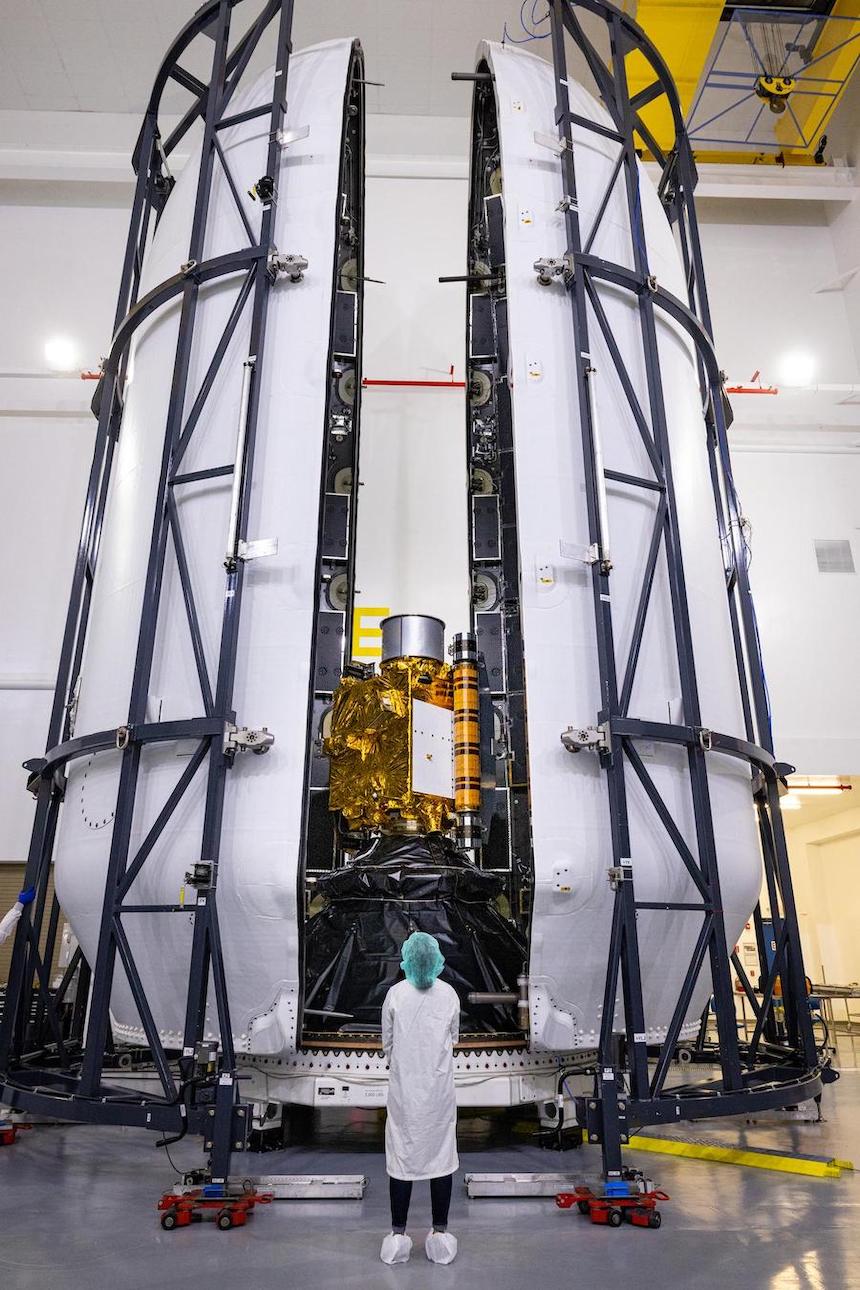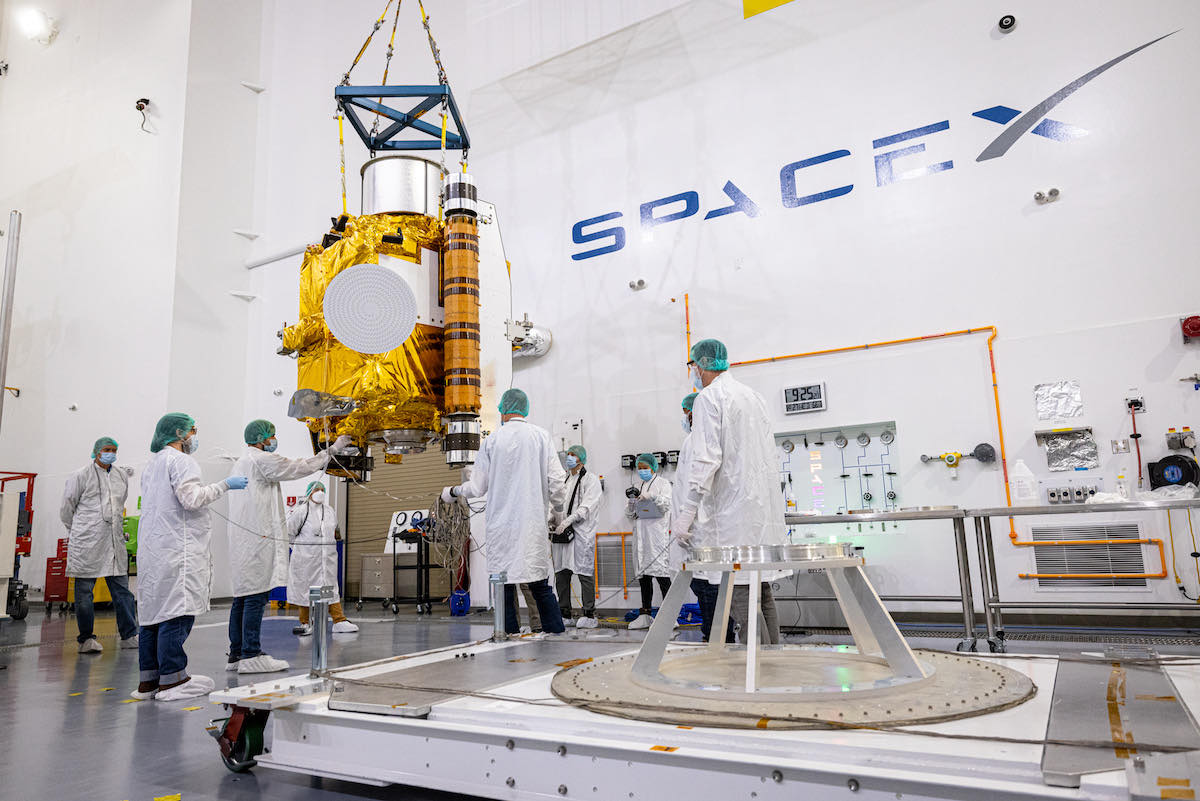
A small NASA spacecraft set to launch on a collision course with an asteroid has been encapsulated inside the payload fairing of its Falcon 9 rocket for blastoff from California this week, a mission that will mark SpaceX’s first launch with a solar system science probe.
NASA’s Double Asteroid Redirection Test, or DART, mission will mark the first time a spacecraft will demonstrate a planetary defense technique that could protect Earth from a future threatening asteroid.
The $330 million mission is small in scale compared to many of NASA’s interplanetary probes. Instead of traveling across the solar system for years, the 1,345-pound (610-kilogram) DART spacecraft will blast off on a 10-month one-way trip to a pair of asteroids named Didymos and Dimorphos.
The mission take aim on Dimorphos, the smaller of the two asteroids, and crash into it. Astronomers on Earth, some 6.8 million miles (11 million kilometers) will measure how the kinetic impact changes the orbit of Dimorphos around its larger companion Didymos.
“Our mission is to hit an asteroid at 15,000 mph (24,000 kilometers per hour),” said Ed Reynolds, DART project manager at the Johns Hopkins University Applied Physics Laboratory. “That’s rough. That’s hard. We’ve worked really, really hard to design a mission that will hit the moon of an asteroid system.”
Assuming the mission blasts off from Vandenberg Space Force Base at 1:21:02 a.m. EST Wednesday (10:21:02 p.m. PST Tuesday), DART will reach Dimorphos on Sept. 26, 2022.
DART is the first NASA interplanetary probe to launch on a SpaceX rocket.
“Everything on the rocket is looking great for launch,” said Julianna Scheiman, director for civil satellite missions at SpaceX, in a pre-launch press conference Monday afternoon. “We’re planning to roll out this evening, and we’re not tracking any issues.”
DART will fly on a Falcon 9 rocket powered by a twice-flown reusable first stage. Designated B1063 in SpaceX’s fleet, the booster launched from Vandenberg on its first flight last November to carry the Sentinel-6 Michael Freilich oceanography satellite into space.
After landing back at Vandenberg, the booster was transported across the country to Cape Canaveral for a launch with 60 Starlink internet satellites May 26. SpaceX shipped the rocket by truck back to California for the launch with DART.
On this mission, the Falcon 9’s first stage will shut down its Merlin 1D engines about two-and-a-half minutes into the mission, then begin maneuvers toward a landing on a SpaceX drone ship parked downrange in the Pacific Ocean.
The Falcon 9 upper stage will continue heading south over the Pacific, firing its single Merlin engine to propel DART on an escape trajectory away from Earth and into the solar system.
Didymos and Dimorphos orbit the sun in an elongated path that occasionally bring them into Earth’s neighborhood. That makes them potentially hazardous asteroids, although scientists say there is no near-term threat from the pair. No space mission has ever explored Didymos and Dimorphos, but scientists who have observed them through telescopes say the asteroids are about a half-mile (780 meters) and 525 feet (160 meters) in diameter, respectively.
“It’s an intentional crash of a spacecraft into a rock,” said Thomas Zurbuchen, associate administrator for NASA’s science mission directorate. “Of course, what we’re trying to learn is how to deflect a threat that would come in. Rest assured, that rock, right now, is not a threat, and it will not be a threat before or after. Of all the near-Earth objects we know today, none of them are a threat within 100 years or so.”

Scientists estimate there should be around 25,000 near-Earth asteroids the size of Dimorphos, with the approximate dimensions of a football stadium. An asteroid of that size that impacts Earth could wipe out a metropolitan area, causing mass casualties.
NASA says surveys have discovered around 40% of similar-sized near-Earth asteroids. Scientists have found more than 95% of the population of larger 1-kilometer-class (0.6-mile) near-Earth asteroids, which could wreak global damage if they hit our planet. The percentage is much lower for the smaller asteroids, but they pose a more limited risk.
DART is the first space mission in NASA’s planetary defense program. The agency plans to launch its next planetary defense mission, an infrared telescope, in 2026 to find most of the undetected dangerous near-Earth asteroids.
The DART spacecraft arrived at Vandenberg on Oct. 2 after a cross-country trip by truck from the Johns Hopkins University Applied Physics Laboratory in Laurel, Maryland.
A small CubeSat provided by the Italian Space Agency will ride to space with DART, then deploy about 10 days before impact. The ridealong spacecraft, named LICIACube, will maneuver to a trajectory offset from DART, allowing it to safely fly by and watch the collision with a pair of optical cameras.
Since DART’s at Vandenberg, ground teams tested the spacecraft to ensure it survived the transport from Maryland, then loaded around 110 pounds (50 kilograms) of hydrazine fuel to feed the probe’s 12 small rocket thrusters. The rocket jets will be used for fine pointing and maneuvers of spacecraft during its flight to Didymos and Dimorphos.
The DART spacecraft shipped from the Applied Physics Laboratory with xenon gas already loaded for its ion propulsion system. The mission will be the first for a new high-efficiency electric thruster developed by NASA’s Glenn Research Center and Aerojet Rocketdyne.
The NASA Evolutionary Xenon Thruster-Commercial, or NEXT-C, thruster is a technology demonstration component of the DART mission. The new thruster is an upgraded, more powerful version of ion propulsion system used on previous NASA deep space probes.
Ion propulsion systems operate at low thrust, but they can fire continuously for months or years while consuming relatively little fuel. They work by accelerating ionized gas using electricity. In DART’s case, the electricity will be generated by two roll-out solar panels.
The DART mission was supposed to launch in July, but NASA announced earlier this year that the launch would slip to November due delays in delivering the spacecraft’s primary instrument and solar arrays.
NASA said the delay was caused by “technical challenges” associated with the spacecraft’s Didymos Reconnaissance and Asteroid Camera for Optical navigation, or DRACO, imaging system, which needed to be reinforced to ensure it can survive the stresses of a rocket launch.
The DRACO camera will take pictures of the Didymos and Dimorphos asteroids just before impact.
The delivery of the spacecraft’s Roll-Out Solar Arrays, known as ROSA, was delayed due to supply chain issues, partly blamed on the COVID-19 pandemic.

DART was originally slated to fly as a secondary payload on a commercial launch, but NASA in 2019 chose SpaceX to launch the mission on a dedicated ride. NASA awarded SpaceX a $69 million contract for the launch from Vandenberg Space Force Base, the company’s first mission with a spacecraft heading to another planetary body.
It won’t be SpaceX’s first launch on an Earth escape trajectory. That happened in 2018, when SpaceX dispatched a Tesla Roadster into the solar system on a stylish debut of the company’s Falcon Heavy rocket.
But the Tesla was not a science probe, and it didn’t launch on a course to visit a planet or asteroid.
DART is the first of a growing list of solar system exploration missions booked to launch with SpaceX.
A Falcon Heavy rocket is scheduled for launch next August with NASA’s Psyche robotic science mission to visit a large metal-rich asteroid. Another Falcon Heavy is assigned to launch NASA’s flagship Europa Clipper spacecraft toward Jupiter in October 2024.
There are also commercial lunar landers and a South Korean moon orbiter in SpaceX’s backlog to fly on future Falcon 9 and Falcon Heavy missions.
Email the author.
Follow Stephen Clark on Twitter: @StephenClark1.
from Spaceflight Now https://ift.tt/3nGIVNA
via World Space Info







0 comments:
Post a Comment